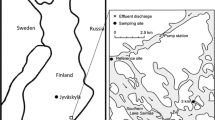Abstract
In order to assess the effects of pollution on recruitment of brown trout (Salmo trutta f. fario L.) exposure experiments with brown trout early life stages were performed in two differently contaminated small streams near Stuttgart, southwest Germany, and in a control situation in the laboratory. Pollution in the more polluted stream is mainly due to effluents of municipal sewage treatment plants and to the influx of surface waters from areas of intense agriculture activity. Additionally, the water carries high particle loads, especially after rainfall events. Water quality of the less polluted stream is occasionally influenced by agriculture activity in the vicinity. For the exposure of trout early life stages incubators were used, which allowed frequent examinations without serious disturbance of the exposed organisms and thus the development could be monitored over time. Compared to the less polluted stream and the control, in the more polluted stream high mortality rates, the lowest hatching success, and lowest values for growth occurred. In the less polluted stream, mortality rates were comparably low in prehatching stages, but high in hatchlings and juveniles due to heavy infestations with protozoic ectoparasites Chilodonella cyprini (Moroff, 1902) and Ichthyobodo necator (Henneguy, 1883). However, pollution-related effects were not detected in this stream. Differences in developmental rates between the different treatments were correlated with different water temperatures in the two streams and the control. For the more polluted stream, previous studies have indicated embryotoxic potentials mediated by pollutants. The present study indicates that in this steam, additionally, fine solids which infiltrate stream gravels may seriously affect development of brown trout early life stages.
Similar content being viewed by others
References
Adam, S., 1999. Limnologisch-zoozönotische Untersuchungen an kleinen Fließgewässern im Raum Stuttgart. Tectum-Verlag, Marburg: 169 pp.
Adam, S., M. Pawert, R. Lehmann, B. Roth, E. Müller & R. Triebskorn, 2001. Physicochemical and morphological characterization of two small polluted streams in southwest Germany. J. aquat. Ecosyst. Stress 8: 179–194.
Balon, E. K., 1975. Terminology of intervals in fish development. J. Fish Res. Bd Can. 32: 1663–1670.
Crisp, D. T., 1988. Prediction, from temperature, of eying, hatching and "swim-up’ times for salmonid embryos. Freshwat. Biol. 19: 41–48.
Crisp, D. T., 1989. Some impacts of human activities on trout, Salmo trutta, populations. Freshwat. Biol. 21: 21–33
Crisp, D. T., 1996. Environmental requirements of common riverine European salmonid fish species in fresh water with particular reference to physical and chemical aspects. Hydrobiologia 323: 201–221.
Crisp, D. T., 2000. Trout and Salmon; Ecology, Conservation and Rehabilitation. Blackwell Science, Oxford: 212 pp.
Elliott, J. M., U. A. Humpesch & M. A. Hurley, 1987. A comparative study of eight mathematical models for the relationship between water temperature and hatching time of eggs of freshwater fish. Arch. Hydrobiol. 109: 257–277.
Fulton, T. W., 1904: The Rate of Growth of Fishes. 22nd Ann. Rep. Fisher. B. Scotland (1903), P. III, 141–241, pl. VI–XII.
Harris, G. S., 1973. A simple egg box planting technique for estimating the survival of eggs deposited in stream gravel. J. Fish Biol. 5: 85–88.
Honnen, W., K. Rath, T. Schlegel, A. Schwinger & D. Frahne, 2001. Chemical analyses of water, sediment and biota in two small streams in southwest Germany. J. aquat. Ecosyst. Stress 8: 195–213
Houde, E. D., 1989. Subleties and epsisodes in the early life of fishes. J. Fish Biol. 35: 29–38.
Hulsman P. F., P. M. Powles & J. M. Gunn, 1983. Mortality of walleye eggs and rainbow trout yolk-sac larvae in low-pH waters of the LaCloche mountain area, Ontario. Trans. am. Fish. Soc. 112: 680–688.
Ingendahl, D. & D. Neumann, 1996. Possibilities for successful reproduction of reintroduced salmon in tributaries of the River Rhine. Arch. Hydrobiol. 113 (Suppl. 1–4): 333–337.
Luckenbach, T., R. Triebskorn, E. Müller & A. Oberemm, 2001. Toxicity of waters from two streams to early life stages of brown trout (Salmo trutta f. fario L.), tested under semi-field conditions. Chemosphere 45: 571–579
Sachs, L., 1997. Angewandte Statistik, Anwendung statistischer Methoden. Springer, Berlin, Heidelberg: 881 pp.
Schwaiger J., 2001. Histopathological alterations and parasite infection in fish: Indicators of multiple stress factors. J. aquat. Ecosyst. Stress. Recov. 8: 231–240
Schwaiger, J., E. Irmler, E. Müller, R. Wanke & R. Triebskorn, 1998. Histopathological alterations of the skin as indicators for multiple environmental stressors. Pap. Pres. 8th Ann. Meet. SETAC Europe, Bordeaux, 14–18 April.
Segner, H., R. Marthaler & M. Linnenbach, 1988. Growth, aluminium uptake and mucous cell morphometrics of early life stages of brown trout, Salmo trutta, in low pH water. Environ. Biol. Fishes 21(2): 153–159.
Siligato, S. & J. Böhmer, 2001. Using indicators of fish health at multiple levels of biological organization to assess effects of stream pollution in southwest Germany. J. aquat. Ecosyst. Stress. Recov. 8: 371–386.
Silver, J., C. E. Warren & P. Doudoroff, 1963. Dissolved oxygen requirements of developing steelhead trout and chinook salmon embryos at different water velocities. Trans. am. Fish. Soc. 92(4): 327–343.
Triebskorn, R., H.-R. Köhler, W. Honnen, M. Schramm, S. M. Adams & E. Müller, 1997. Induction of heat shock proteins, changes in liver ultrastructure, and alterations of fish behavior: are these biomarkers related and are they useful to reflect the state of pollution in the field? J. aquat. Ecosys. Stress Recov. 6: 57–73.
Turnpenny, A.W. H. & R. Williams, 1980. Effects of sedimentation on the gravels of an industrial river system. J. Fish Biol. 17: 681–693.
Urawa, S., 1992. Epidermal responses of chum salmon (Oncorhynchus keta) fry to the ectoparasitic flagellate Ichthyobodo necator. Can. J. Zool. 70: 1567–1575.
Von Westernhagen, H., 1988. Sublethal effects of pollutants on fish eggs and larvae. In Hoar, W. S. & D. J. Randall (eds), Fish Physiology, Vol. 11, Part A. Academic Press, San Diego, CA: 253–346.
Author information
Authors and Affiliations
Rights and permissions
About this article
Cite this article
Luckenbach, T., Kilian, M., Triebskorn, R. et al. Assessment of the developmental success of brown trout (Salmo trutta f. fario L.) embryos in two differently polluted streams in Germany. Hydrobiologia 490, 53–62 (2003). https://doi.org/10.1023/A:1023477509925
Issue Date:
DOI: https://doi.org/10.1023/A:1023477509925




